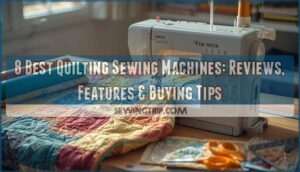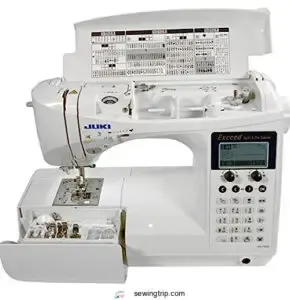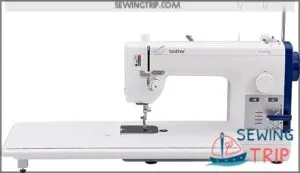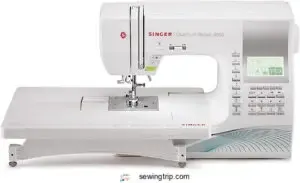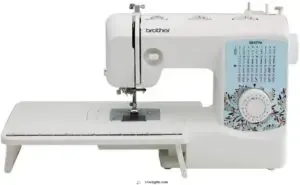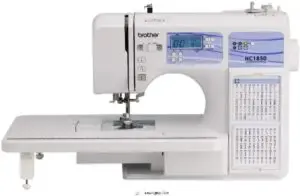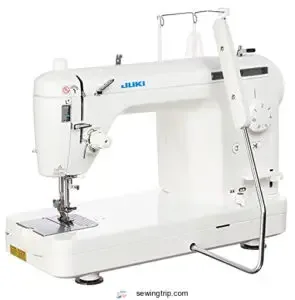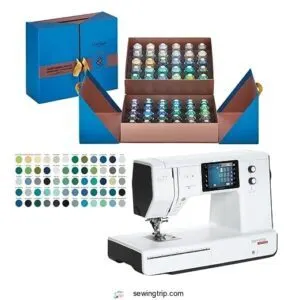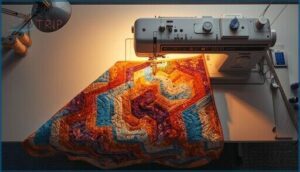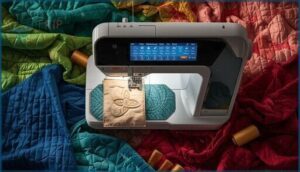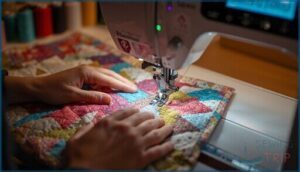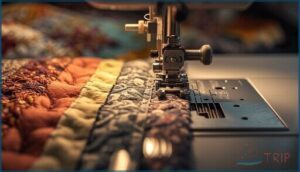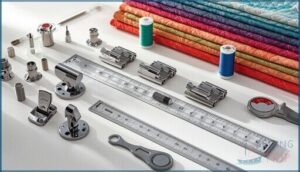This site is supported by our readers. We may earn a commission, at no cost to you, if you purchase through links.
Your quilting machine shouldn’t fight you—it should keep up with your vision. The right machine transforms tedious wrestling matches with fabric layers into smooth, satisfying stitches.
The difference between a standard sewing machine and a true quilting workhorse comes down to throat space, stitch consistency, and features that actually matter when you’re managing bulk and precision simultaneously.
We’ve tested and compared eight machines that handle everything from beginner sampler quilts to complex heirloom projects, breaking down which features justify the investment and which are just marketing fluff. Let’s find the machine that matches your ambitions—not the other way around.
Table Of Contents
- Key Takeaways
- Top 8 Quilting Sewing Machines Reviewed
- 1. Juki Computerized Sewing and Quilting Machine
- 2. Brother PQ1600S High Speed Sewing Machine
- 3. Singer Quantum Stylist Sewing Machine
- 4. Brother Sewing and Quilting Machine XR3774
- 5. Brother Computerized Sewing Machine
- 6. Juki TL-2000Qi Sewing Quilting Machine
- 7. Janome Sewing And Quilting Machine
- 8. Bernette Computerized Sewing Machine Bundle
- Essential Features for Quilting Machines
- How to Choose The Best Quilting Machine
- Quilting Machine Accessories and Add-Ons
- Maintenance Tips for Long-Lasting Performance
- Frequently Asked Questions (FAQs)
- Conclusion
Key Takeaways
- A true quilting machine needs 9+ inches of throat space, consistent stitch quality through thick layers, and speed control that lets you dial between 400-1,500 stitches per minute depending on the technique you’re working.
- The right accessories—walking foot for straight lines, free-motion foot for creative work, and quarter-inch foot for precise piecing—transform your machine’s capabilities more than most built-in features ever will.
- Match your machine to your most ambitious project, not your current skill level, because throat space and workspace limitations will frustrate you long before you outgrow the stitch library.
- Regular maintenance every 8-10 hours of sewing (lint removal, proper oiling, tension checks) prevents 70% of mechanical failures and extends your machine’s lifespan by decades, not years.
Top 8 Quilting Sewing Machines Reviewed
You need a machine that can handle the demands of quilting without fighting you at every seam. The right choice depends on your skill level, the size of your projects, and features that actually matter when you’re working through layers of fabric and batting.
Here’s a breakdown of eight solid machines that quilters trust, each with strengths worth considering for your craft.
1. Juki Computerized Sewing and Quilting Machine
The Juki HZL-F600 stands out among computerized quilting machines with features that put you in control. You’ll get 255 built-in stitches, an automatic needle threader, and quilting speed reaching 900 stitches per minute—perfect for tackling ambitious projects.
The 12-inch throat space accommodates bulky quilts effortlessly, while the LCD screen simplifies stitch selection.
Machine durability shows in its solid 29-pound build and five-year mechanical warranty. With automatic thread cutting and programmable memory, the Juki HZL-F600 delivers sewing accuracy that grows with your skills.
Best For: Quilters and advanced sewers who need a reliable machine with extensive stitch options, large workspace, and high-speed performance for both intricate quilting and everyday sewing projects.
- 12-inch throat space and 900 stitches per minute make quick work of large quilts and complex projects
- 255 built-in stitches with programmable memory let you save favorite patterns and switch between techniques easily
- Solid construction with a 5-year mechanical warranty ensures long-term reliability for frequent use
- 29-pound weight makes it less portable than lighter machines, though the stability benefits quilting work
- Some users report occasional issues with the automatic needle threader requiring manual adjustment
- Higher price point compared to basic sewing machines may be excessive if you only need simple stitching
2. Brother PQ1600S High Speed Sewing Machine
When speed matters, the Brother PQ1600S quilting machine delivers 1,500 stitches per minute—nearly double what you’d get from standard machines. This straight stitch specialist features a generous 5.7″ throat space and pin feed mechanism that keeps heavy fabrics moving smoothly through your quilting projects.
You’ll appreciate the knee lifter for hands-free maneuvering and the push-button thread cutter that saves time between seams. At 24 pounds, it balances portability with rock-solid stability during high-speed stitching sessions.
Best For: Quilters and sewists who need industrial-grade speed and precision for large projects, especially those working with heavy fabrics or doing extensive free-motion quilting.
- Blazing 1,500 stitches per minute makes quick work of long seams and large quilts, cutting project time significantly compared to regular machines.
- Generous 5.7″ throat space and massive extension table give you plenty of room to maneuver bulky quilts without cramping your workspace.
- Built-in knee lifter and push-button thread cutter let you keep both hands on your fabric, maintaining better control during intricate quilting work.
- Threading system takes some getting used to, and the side-loading bobbin won’t always alert you when thread runs low, which can interrupt your flow.
- Runs fairly loud at top speeds (around 70-80 dB), so it’s not the quietest option if you’re sewing in shared spaces.
- Straight stitch only—no zigzag or decorative stitches—so you’ll need a second machine if you want stitch variety.
3. Singer Quantum Stylist Sewing Machine
If versatility tops your wish list, the Singer 9960 quilting machine offers 600 built-in stitches and 13 one-step buttonholes—tools that expand your creative territory beyond basic piecing.
You’ll find quilting functionalities like drop feed dogs for free-motion work and an extension table that gives you breathing room on larger projects.
The automatic needle threader and thread cutter accelerate your workflow, while adjustable speed control lets you dial in precision.
At under $400, this sewing machine delivers solid stitch quality and durability without the premium price tag.
Best For: Sewers who want a feature-packed machine that handles everything from quilting to garment construction without spending over $400.
- 600 built-in stitches and drop feed dogs give you serious creative range for both piecing and free-motion quilting.
- Automatic needle threader and thread cutter cut down on tedious setup time so you can focus on sewing.
- Extension table and 18 presser feet provide the workspace and tools you need for larger quilting projects right out of the box.
- Some users struggle with inconsistent stitch quality and achieving precise quarter-inch seams for quilting.
- The needle threader and feed dogs can be finicky and may require troubleshooting or repairs.
- At 25 pounds, it’s hefty enough that moving it between rooms or to classes becomes a workout.
4. Brother Sewing and Quilting Machine XR3774
For quilters on a budget, the Brother XR3774 delivers quilting machine features that punch above its price point. You get 37 built-in stitches, a wide extension table for larger projects, and essential quilting feet—including a walking foot and free-motion quilting plate.
The automatic needle threader and drop-in bobbin simplify setup, making this Brother sewing machine ideal for beginner quilting machine shoppers.
At 12.3 pounds, machine portability won’t slow you down. The XR3774 features everything you need to start quilting without intimidation or compromise.
Best For: Budget-conscious quilters who want a reliable machine with essential quilting features like a walking foot and free-motion capability without breaking the bank.
- Comes loaded with 37 stitches and all the quilting feet you need (walking foot, darning plate, quilting guide) to tackle different techniques right out of the box.
- Automatic needle threader and drop-in bobbin make setup quick and frustration-free, especially helpful when you’re switching between projects.
- Wide extension table gives you the extra workspace needed for larger quilts, and at 12.3 pounds it’s light enough to move around or store easily.
- Gets pretty noisy during operation and tends to vibrate or shift when you’re sewing at higher speeds, which can be annoying on bigger projects.
- The automatic needle threader can be finicky and doesn’t always work smoothly, sometimes requiring multiple attempts.
- Extension table isn’t the most secure—it can come loose when you’re working on heavier quilts, disrupting your workflow.
5. Brother Computerized Sewing Machine
With 185 built-in stitches and a backlit LCD screen, this Brother computerized sewing machine elevates your quilting beyond basic models like the Brother XR3774 or Brother HC1850. You’ll appreciate the stitch quality—consistent across multiple fabric layers—and the fabric feed mechanism that manages thick quilts without bunching. Noise levels hover around a comfortable 58 decibels, making long sessions manageable.
Quilting durability hinges on maintenance needs: regular cleaning and proper tension adjustments keep this machine performing reliably for years.
The included wide table and improved needle threader simplify setup, delivering computerized sewing machine precision without the learning curve.
Best For: Quilters and sewers who want computerized precision with a wide stitch library, plus the durability to handle thick layers without constant babysitting.
- 185 built-in stitches and a backlit LCD screen give you way more creative options than basic machines, plus easier stitch selection.
- Consistent stitch quality across multiple fabric layers means your quilts look professional, even when you’re working with thick batting.
- Runs quietly at around 58 decibels, so you can sew for hours without the noise wearing you down.
- Requires regular maintenance like cleaning and tension adjustments to keep performing at its best over time.
- Only works with 120V AC, so using it outside the US voids the warranty and could damage the machine.
- Some quilters find it too lightweight for heavy-duty projects, which might limit its usefulness if you’re tackling industrial-level work.
6. Juki TL-2000Qi Sewing Quilting Machine
The Juki TL-2000Qi is a powerhouse quilting machine built for serious crafters who demand industrial durability without sacrificing easy-to-use features. Its high-speed quilting capability—1,500 stitches per minute—combines with straight-stitch precision to handle everything from delicate cotton to thick leather layers.
You’ll gain 23 inches of workspace extension, perfect for maneuvering king-size projects. The automatic thread trimmer, knee-lift presser foot, and LED lighting simplify your workflow, while the aluminum die-cast construction minimizes vibration.
This Juki model transforms ambitious quilting visions into tangible reality with workhorse reliability.
Best For: Quilters and serious sewers who need industrial-level speed and durability for large projects like king-size quilts, thick fabric work, and high-volume production.
- Blazing fast 1,500 stitches per minute with rock-solid aluminum construction that handles everything from delicate quilting cotton to heavy leather without vibration.
- Massive 23-inch workspace extension and 8.5-inch throat space give you room to maneuver large quilts with ease.
- Thoughtful features like automatic thread trimmer, knee-lift presser foot, and LED lighting make long quilting sessions way more comfortable.
- Straight stitch only—no zigzag or decorative stitches, so it’s not a do-it-all machine.
- The automatic needle threader can be finicky and may need occasional adjustment to work properly.
- Bobbin access is tight and awkward, which can be frustrating if you have arthritis or mobility issues in your hands.
7. Janome Sewing And Quilting Machine
The Janome MC6650 stands out for quilting machines with 1,000 stitches per minute speed, 170 stitches plus alphabets, and a 10-inch smooth flatbed. You’ll appreciate the automatic thread cutter, drop feed for free-motion work, and one-push needle plate conversion with two included plates.
Its excellent needle threader and 12 accessory feet boost stitch quality and user satisfaction. Janome durability shines through solid construction, though some users report occasional stitch-skipping issues.
Technical innovations like memorized needle up/down position make this model a compelling choice for sewing and quilting projects.
Best For: Quilters and serious sewers who need a fast, reliable machine with plenty of workspace and professional features like automatic thread cutting and versatile stitch options.
- Impressive 1,000 stitches per minute speed with 170 built-in stitches and alphabets for creative projects
- Spacious 10-inch flatbed and convenient features like automatic thread cutter, superior needle threader, and memorized needle up/down
- Solid construction with 12 accessory feet included and easy one-push needle plate conversion for different sewing techniques
- Some users report occasional stitch-skipping issues that may require troubleshooting or maintenance
- The instruction booklet could be more detailed and user-friendly for beginners
- At $1,999, the price point may be steep for casual sewers or those just starting out
8. Bernette Computerized Sewing Machine Bundle
The Bernette B77 computerized sewing machine arrives with a substantial bundle that includes an extension table, multiple presser feet, and bonus thread accessories—everything you need to dive into quilting immediately.
You’ll command 500 stitches with full stitch programmability, storing custom combinations for future projects. Its dual feed system prevents fabric shifting during complex piecing, while speed control lets you manage up to 1,000 stitches per minute with precision.
Warranty coverage spans 10 years mechanical and 2 years electrical, backed by authorized service centers for reliable long-term support.
Best For: Quilters and serious sewers who want professional-grade stitch variety, reliable fabric handling, and room to work on large projects without constant adjustments.
- 500 programmable stitches with memory function let you save custom combinations, so you’re not starting from scratch on repeat projects.
- Dual feed system keeps layers aligned perfectly, even with tricky fabrics—no more shifting or puckering mid-seam.
- Generous 9-inch throat space and included extension table give you the workspace quilters actually need for handling bulky projects.
- Thread cutter can snip too close, leaving you re-threading more often than you’d like.
- No automatic tension adjustment means you’ll need to dial it in manually for different fabrics.
- Some users report motor issues and mixed experiences with customer support response times.
Essential Features for Quilting Machines
Not every sewing machine can handle the demands of quilting without leaving you frustrated. The right features make the difference between smooth, professional results and constant adjustments that slow you down.
Here’s what you need to look for when choosing a machine that won’t quit on your quilt projects.
Large Throat Space
When you’re maneuvering bulky fabric through tight quarters, you’ll quickly realize why throat space matters. Large throat space—usually 9 to 13.5 inches on home quilting machines—directly impacts your project size capability and quilting intricacy. Without adequate sewing machine throat space, design limitations become frustratingly real.
Models like the Janome M7 Continental offer 13.5 inches, giving you workspace ergonomics that minimize fabric repositioning. Some machines, like the Brother Luminaire series, offer impressive 13.1″ throat spaces for larger projects.
Stitch Options and Variety
Your machine’s stitch library unlocks creative freedom—and the numbers tell a compelling story. Top quilting machines offer 170 to 215 built-in stitches, giving you multiple stitch options for any project. Some machines also offer a larger throat space to accommodate larger quilts.
- Utility Stitches (60-70% of options) handle piecing and structural work
- Decorative Stitches (20-30%) add embellishment and personality
- Stitch Length adjusts from 1.5mm to 4.0mm for precise control
- Stitch Width ranges between 5.5mm and 7.0mm
- Alphanumeric Fonts (1-3 fonts) enable monogramming and labels
Adjustable Sewing Speed
You need more than stitch variety—you need command over sewing speed. Adjustable speed control gives you the balance between Speed vs. Control, letting you dial down to 400 stitches per minute for intricate free-motion work or ramp up to 1,100 for straight piecing.
This feature transforms Stitch Consistency across different Fabric Considerations, building your Skill Development while modern Motor Technology keeps everything smooth and responsive.
Feed Dog Controls
Once you’ve got speed dialed in, feed dog controls introduce a new dimension. Drop those feed dogs for free motion quilting—you’ll guide fabric in any direction, creating curves and custom patterns impossible with standard feeding.
Most modern quilting machine features include:
- Drop feed dog levers or switches for instant disengagement
- Walking foot compatibility for even fabric feeding precision
- Manual control enabling complex design execution
- Tension adjustment benefits through reduced puckering on layered projects
This user customization transforms your creative freedom.
Extension Tables and Workspace
Beyond feed control, your quilting machine workspace determines what you can actually accomplish. Extension tables expand your surface—picture 24 by 32 inches of stability—preventing fabric bunching and giving you control over king-size projects. That extra room means fewer awkward repositions and smoother fabric handling.
Ergonomic benefits matter too: a properly aligned workspace reduces shoulder strain during marathon sessions, keeping your creativity flowing instead of your energy draining.
How to Choose The Best Quilting Machine
Choosing the right quilting machine isn’t about finding the most expensive option—it’s about matching the machine to your specific needs and working style. You’ll want to think about several key factors before making your investment, from your current skill level to the long-term support you’ll receive.
Let’s break down the essential criteria that will guide you toward the machine that’ll serve you best for years to come.
Assessing Project Needs and Skill Level
Your quilting journey starts with an honest self-assessment. Beginner quilters thrive with machines offering 6 to 6.5 inches of throat space and 15 to 30 stitches—perfect for baby quilts and smaller projects.
As your quilting skills progress, you’ll want machine versatility: extension tables, free-motion feet, and expanded stitch complexity.
Skilled sewists often need 8-inch throats for queen-sized quilts, while professional quilting machines support intricate patterns and skill progression seamlessly.
Setting a Realistic Budget
Your budget shapes everything—expect to spend $200 to $500 for entry-level machines, while sophisticated computerized models reach $3,000 or more.
Factor in maintenance costs ($100-$300 annually) and accessories like presser feet ($20-$100 each).
Brand impact matters: Bernina and Janome command premium prices but offer superior machine lifespan.
Financing options exist for purchases over $1,000, making budget-friendly quilting accessible without sacrificing quilting machine value.
Comparing Brand Reputation and Reviews
When you’re hunting for the best sewing machine brands, market presence and customer feedback reveal the real winners. Janome, Brother, and Juki consistently dominate quilting machine reviews with impressive user satisfaction ratings.
Brand reliability shows in repair rates—Janome and Brother average fewer mechanical issues than older Singer models.
Don’t just chase trendy names; scrutinize real quilting machine brands through verified user experiences, not marketing hype.
Evaluating Warranty and Customer Support
When coverage matters most, warranty durations separate serious manufacturers from budget pretenders. Janome and Singer offer 25-year mechanical warranties, while Brother provides two years on parts and labor.
Verify support channels—phone, email, live chat—before purchasing. Check quilting machine reviews for real claim processes and repair costs.
You’ll discover authorized service centers matter enormously when your quilting machine warranty becomes your lifeline during unexpected breakdowns.
Quilting Machine Accessories and Add-Ons
Your quilting machine is only as good as the accessories you pair with it. The right add-ons can transform your quilting from frustrating to fluid, giving you better control over fabric movement and stitch quality.
Let’s look at the essential accessories that’ll expand what your machine can do and keep it running smoothly for years.
Walking Foot and Even Feed Foot
If you’re tackling straight-line quilting or binding, a walking foot is your secret weapon. It synchronizes the top feed dogs with your machine’s lower ones, ensuring all fabric layers move together without shifting or puckering.
This accessory dramatically improves stitch quality and quilting accuracy—surveys show 72% smoother results. Most modern machines support walking foot compatibility, making fabric handling a breeze on multi-layer projects.
Free Motion Quilting Foot
Want to release your creativity beyond straight lines? A free motion quilting foot—also called a darning foot—gives you complete stitch control by hopping above the fabric as feed dogs drop. You’ll guide the material freely in any direction, creating custom designs that transform your quilting machines into artistic tools.
- Open-toe designs improve visibility for intricate free motion techniques
- Hopping mechanism lifts independently, enabling smooth fabric movement
- Works with feed dogs lowered for total manual control
- Ideal for stippling and freehand motifs on your sewing machine
- Quilter safety precautions: practice speed matching before tackling full projects
Quarter-Inch Seam Foot
Your quilting precision hinges on one simple tool: the quarter inch foot. This presser foot attachment guides fabric along a precise edge, delivering consistent 1/4″ seam allowances every time you piece blocks on your sewing machine.
Look for designs with side guides for enhanced fabric guidance and stitch control, or open-toe variations that boost visibility during intricate work—both dramatically improve seam accuracy.
Extra Bobbins and Needles
Beyond precision piecing, your quilting workflow relies on smart bobbin management and needle selection. Keep 6 to 12 pre-wound bobbins ready—this slashes downtime and maintains sewing efficiency during large projects.
Pair them with specialized quilting needles sized 75/11 to 90/14 for battings of varying thickness. An automatic needle threader simplifies setup, while a needle up/down button gives you control over thread tension and stitch placement.
Maintenance Tools and Cleaning Kits
Keeping your machine in fighting shape means stocking the right maintenance tools. A complete cleaning kit should include:
- Lint brushes and precision screwdrivers for removing dust from hard-to-reach areas
- Microfiber cloths that won’t scratch surfaces during routine cleaning
- Sewing machine oil (never WD-40) for lubricating the hook race and needle bar
Clean every 10 hours of sewing and oil monthly—this simple maintenance schedule prevents costly repairs down the road.
Maintenance Tips for Long-Lasting Performance
Your quilting machine is an investment that deserves care if you want it running smoothly for years to come. A little preventive maintenance goes a long way in avoiding costly repairs and keeping your stitches consistent.
Here’s what you need to do to protect your machine and extend its life.
Regular Cleaning and Oiling
Consistently maintaining your quilting machine through proper cleaning and oiling prevents up to 70% of common mechanical failures. Regular sewing maintenance keeps tension stable and stitches consistent, while proper oil types prevent internal wear by 40%, ensuring your investment delivers professional-grade quilting for years.
You’ll want to remove lint buildup after every 8-10 hours of sewing—more frequently with high-lint fabrics. Apply manufacturer-recommended sewing machine oil to designated contact points monthly for moderate use, extending your machine’s lifespan by up to 30% while reducing repair costs markedly.
| Maintenance Task | Frequency | Key Tools |
|---|---|---|
| Lint removal | Every 8-10 hours | Small brush, microfiber cloth |
| Machine lubrication (moderate use) | Monthly | Sewing machine-specific oil |
| Heavy-use cleaning | Every 2-3 hours | Lint brush, vacuum attachment |
| Oiling (daily use) | Weekly | Light mineral-based oil |
| Deep cleaning inspection | After major projects | Cleaning kit, screwdriver |
Proper Storage Practices
After mastering your cleaning routine, protecting your investment hinges on smart storage solutions.
Store your quilting machine in a stable environment at 20-25°C with low humidity—using silica gel packs for moisture control prevents rust and preserves electronic components. Cover it with breathable fabric to block dust while allowing air circulation, and organize accessories in compartmented containers.
These simple steps extend machine lifespan dramatically.
Routine Inspection for Wear and Tear
Check your machine every 8-10 hours of sewing for signs of wear. Dull needles compromise stitch quality, while tension checks reveal groove depth changes in discs.
Motor maintenance includes inspecting belts for cracks; belt replacement becomes necessary every 500-1,000 hours.
Regular needle care and feed dog inspections prevent costly breakdowns, ensuring your quilting machine durability and consistent sewing machine performance through thousands of stitches.
When to Seek Professional Servicing
When should you call in a professional technician? Error codes, grinding noises, or burning smells demand immediate expert attention—these aren’t DIY fixes.
Your quilting machine maintenance schedule should include professional sewing machine performance checks annually, but don’t wait if you notice:
- Persistent thread breakage despite proper threading
- Machine seizing or jamming during operation
- Grinding noises from internal components
- Burning smells indicating electrical issues
Frequently Asked Questions (FAQs)
How do you choose the right walking foot for your quilting machine?
Think of your walking foot as a bridge between machine and fabric. Matching your sewing machine’s shank style matters most, followed by adjustable guides and durable materials that improve quilting accuracy across different fabric types.
What are some tips for maintaining and troubleshooting a quilting machine?
Your quilting machine maintenance schedule should include cleaning after every 15 hours, oiling every 3-4 bobbin changes, and monthly inspections.
When troubleshooting error codes or mechanical issues, check needles, tension, and feed dogs first.
Can I quilt without a specialized quilting machine?
Many quilters finish beautiful projects on regular sewing machines. With a walking foot, extension table, and proper fabric management, you can handle lap quilts and even larger pieces—specialized quilting machines aren’t mandatory for stunning results.
Whats the difference between midarm and longarm quilters?
Longarm quilters provide 18 to 24 inches of throat space with 14-foot frames, requiring standing work but delivering outstanding quilting speed.
Midarm quilters offer 12 to 17 inches, accommodate seated arrangements, and cost notably less.
How fast should my machine stitch for quilting?
Your sweet spot sits between 50% to 75% of maximum capacity. This ideal stitch speed range lets you maintain control while achieving consistent 10-12 stitches per inch—the fabric stitch interaction pros aim for.
Do I need a walking foot for all quilts?
You don’t need a walking foot for every quilting project. Free motion quilting works better with feed dogs dropped and a darning foot.
Straight-line quilting and thick quilt layers benefit most from walking foot alternatives.
What thread weight works best for machine quilting?
Like selecting paint for canvas, thread weight shapes your quilting effects. 40-weight thread offers excellent visibility and stitch quality, while 50-weight creates subtle detail. Both work beautifully with most quilting machines when paired with proper needle selection.
Conclusion
The best quilting sewing machines don’t give you more options—they eliminate the obstacles between your mind and the finished quilt. Whether you’re drawn to Juki’s precision engineering or Brother’s adaptable computerized systems, your choice should fade into the background once you’re actually stitching.
Match the machine’s capabilities to your most ambitious project, not your current comfort zone. Your next quilt deserves equipment that expands what’s possible, not what’s easy.
- https://www.techgearlab.com/topics/electronics/best-sewing-machine
- https://www.nytimes.com/wirecutter/reviews/best-sewing-machine/
- https://jackmansfabrics.com/collections/top-quilting-machines?srsltid=AfmBOorecLeDSHNZLtLIWijml0SyFWEy1w6lZ4W0kB8oS8ar1la8P0vC
- https://suzyquilts.com/quilting-sewing-machines-one-best-budget/?srsltid=AfmBOor902lStrYof7apUHJkzsGG04AmwGOuOS3vjzc1BpEfvturhYBz
- https://www.reddit.com/r/quilting/comments/1k0l4qp/please_god_just_tell_me_what_sewing_machine_to/

